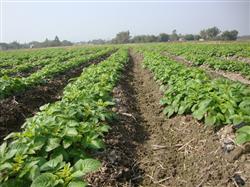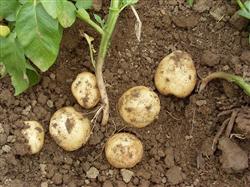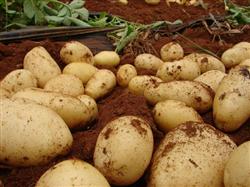How to grow potatoes with high yield?

How to grow potatoes with high yield? Please introduce in detail the following planting methods for high yield of potato: first, variety selection potato is vulnerable to virus infection due to planting in the same plot for many years, and accumulates virus in asexual age, which leads to variety degradation. Therefore, high-yield, high-quality and virus-resistant varieties with high resistance to late blight and cancer are generally selected. 2. Seed potato treatment 1. Disinfect 40% formalin solution 200 times, spray the surface of seed potato or soak seeds for 5 minutes, cover with plastic film for 2 hours, then spread out to dry. 2. It is suitable to sow the whole potato with 0-25g small seed potato, and the large seed potato can be cut into about 25g small pieces, with 1-3 bud eyes on each piece, with top bud eyes as far as possible, and adopt longitudinal cutting. Use two knives when cutting pieces, immediately change the sterilized knife when you encounter sick potatoes, and soak the infected knife in 5% lime water. Cut potato pieces should be put in a cool and ventilated place to dry, or sell plant ash, so that the incision dry to facilitate healing. 3. 20 days before sowing, select the leeward to the sun, good drainage plot to do seedbed, bed width 100cm, deep l0cm, spread moist river sand or fine soil, put a layer of seed potato, cover a layer of sand or fine soil, can put 3-4 layers, cover the surface with 3-4cm thick sand or soil, properly water, and finally cover the film, the film temperature is about 20 ℃, after 15-20 days can germinate. In the process of sprouting, you should often turn the potato pieces to make the germination uniform and sturdy, and when the buds grow to 1.5cm or so, you can sow the seeds. The germination rate can be increased by soaking the seeds with 5-10mg/kg gibberellin for 15 minutes and then putting them into the seedling bed. 3. Soil preparation potato belongs to tuber crops, and its vegetative organs grow underground, so it is more suitable for potato planting on loose sandy soil. At the same time, it is necessary to deeply plough the land, rake flat and fine, make the soil loose, improve the ability of water storage, fertilizer conservation and drought resistance, and then increase the yield. Fertilization 1, base fertilizer per mu application of high-quality rotten hot farm fertilizer 2500-3500kg, nitrogen, phosphorus, potassium and boron and other multi-component compound fertilizer 30-50kg. 2. After topdressing, 5-10kg/ mu of urea was applied according to the growth of potato seedlings combined with clear manure water. 5. Sowing 1. Temperature is an important condition for timely seed description to determine the suitable seed description period. It is required to sow seeds when the average temperature at soil l0cm reaches more than 5 ℃. If the use of plastic film mulching can be advanced to the end of January to early February sowing, "May Day" can be listed one after another. 2. Reasonable close planting dry land zoning rotation 3000-4000 plants / mu, sowing rate 100-150kg, that is, in the dryland zoning rotation 167cm box, potato belt 100cm in 2 rows, row spacing 8cm, nest spacing 20-30cm. 3. Sowing methods: furrow sowing or nest sowing. Organic fertilizer and chemical fertilizer should be applied deeply, and the soil should be covered before sowing to prevent fertilizer damage. Cover the soil and ridge after sowing. 6. Field management 1. After all the seedlings come out, the seedlings should be checked and filled in time to prevent the lack of nests and lines. After topdressing urea at seedling stage, it is necessary to timely ploughing, weeding and soil cultivation in order to facilitate root growth. The plastic film mulching should be broken in time in the first ten days of April (the ground temperature is stable at 16-18 ℃) to prevent the high ground temperature from affecting the expansion of potato blocks. 2. The flowers and buds should be removed from budding to flowering, and lkg/ mu of potassium dihydrogen phosphate should be sprayed at the same time to facilitate the expansion of potato blocks. 3. In the rainy season, ditches should be opened to drain the soil to facilitate root growth and tuber expansion. 4. Disease and pest control. Control late blight with 0.1% copper sulfate solution (50kg/ mu) or 100 Bordeaux solution; control aphids with 1000 times dimethoate (50kg/ mu) or 2000-3000 times EC; and control underground pests with 80% trichlorfon wettable powder (500g/ mu) mixed with poison bait or 1000 times diluted with phoxim. Harvest at the right time when the stems and leaves naturally turn yellow and dry, and when the stem shrinks from the tuber, the yield is the highest, and the potato skin is not easy to scratch, so it is transported and stored. The harvest time can also be arranged reasonably according to the market situation. 8. Store diseased potatoes, damaged potatoes and deformed potatoes without seed coat, and store them separately in cool (1-4 ℃), dry and ventilated places, with each layer thick 50cm. Turn and check every 20 days or so to pick out rotten potatoes to prevent other potato pieces from infecting. Click to get more potato planting techniques click to get more vegetable planting techniques
- Prev

Is there any way to increase production by growing potatoes?
Is there any way to increase production by growing potatoes? Please give instructions to increase the yield of potatoes can use the following methods: after removing the tail buds, it is proved that after the tail buds are grown, the yield is only 1 / 3 of that of the terminal buds or lateral buds, so the tail buds should not be discarded when cutting seed potatoes. High ridge cultivation.
- Next

What are the characteristics of potato fertilizing?
What are the characteristics of potato fertilizing? Please introduce the whole growth period of potato, the type and quantity of nutrients required are also different due to different growth stages. The fertilizer absorption was very little in the seedling stage, but increased rapidly in the rosette stage, reached the peak in the early stage of tuber formation, and then decreased sharply. Give birth to each child.
Related
- Where is it suitable to grow horseradish in China? it is expected to see the middle altitude horseradish in Alishan.
- How to prevent tomato virus disease reasonably? (Control methods included)
- Many people like to plant towel gourd on the balcony. What are the main points of this method and management?
- What crops can chili peppers be mixed with?
- Fertilization techniques and matters needing attention in Tomato
- What are the grafting techniques for peach seedlings in spring?
- Harm and control methods of root swelling disease of Chinese cabbage
- What are the pests of sweet potatoes? How to prevent and cure it?
- Symptoms, causes and Control methods of navel Rot in Tomato
- The cause of "Cucumber rotten bibcock" in Farmers' planting Cucumber and its Control Plan

